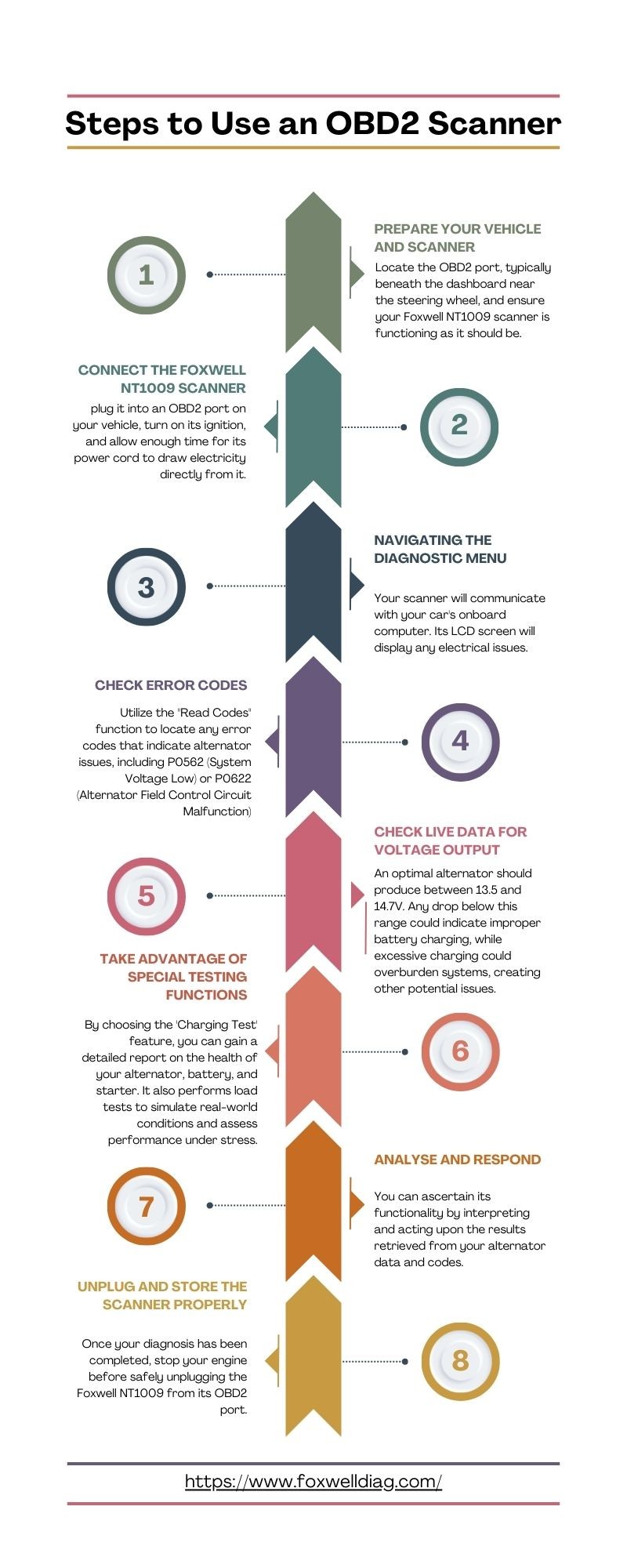Experiencing electrical issues with your car, such as dimming headlights or a battery that keeps dying? It’s natural to suspect the alternator might be the culprit. Before you rush to the mechanic, you might be wondering if your trusty OBD2 scanner can help you diagnose the problem yourself.
The short answer is yes, with some important qualifications.
Let’s delve into how an OBD2 scanner, like the Foxwell NT1009, can be a valuable tool in checking your alternator’s health. We’ll explore its capabilities and limitations, providing you with a step-by-step guide to using it effectively and understanding when further investigation might be needed.
Understanding Your Alternator’s Vital Role
Think of your car’s alternator as the heart of its electrical system. Much like your heart pumps blood throughout your body, the alternator generates the electricity needed to power all your vehicle’s electrical components. This includes everything from your headlights and radio to critical systems like your engine management and safety features.
The alternator’s primary job is to convert mechanical energy from the engine into electrical energy. This not only powers your car’s electronics while it’s running but also recharges the battery, ensuring you have enough power to start your engine again next time.
Alternators, however, are not designed to last forever. Over time, components can wear out, leading to decreased performance or complete failure. Common signs of a failing alternator include:
- Dimming Headlights: Especially noticeable at idle, dim lights can indicate the alternator isn’t producing enough power.
- Slow Engine Start-up: A weak alternator might not properly charge the battery, leading to sluggish engine cranking.
- Dead Battery: If your battery is repeatedly dead, even after jump-starting or replacing it, the alternator could be failing to recharge it.
- Warning Lights: The battery or check engine light might illuminate on your dashboard, signaling an electrical system issue.
- Unusual Noises: Whining or grinding noises from under the hood could indicate a failing alternator bearing.
Recognizing these symptoms early is crucial. Addressing alternator issues promptly can prevent you from being stranded and potentially save you from more costly repairs down the line.
How OBD2 Scanners Assist in Alternator Diagnosis
An OBD2 scanner, such as the popular Foxwell NT1009, can be an incredibly helpful tool when you suspect alternator problems. These devices are designed to communicate with your car’s onboard computer system, reading diagnostic trouble codes (DTCs) and providing live data about various vehicle parameters.
While an OBD2 scanner won’t directly declare “Your alternator is bad!”, it can provide valuable clues and insights into potential alternator issues. It achieves this in a couple of key ways:
- Reading Trouble Codes: When your car’s computer detects an electrical system malfunction, it stores a DTC. An OBD2 scanner can retrieve these codes, which might point to alternator-related problems. For instance, codes like P0562 (System Voltage Low) or P0622 (Alternator Field Control Circuit Malfunction) are strong indicators of alternator trouble.
- Monitoring Live Data: OBD2 scanners can display real-time data from your vehicle’s sensors. Crucially, this includes voltage readings. Monitoring the voltage output while the engine is running is a key way to assess alternator performance. A healthy alternator should maintain a specific voltage range to charge the battery and power electrical systems effectively.
Alt Text: Infographic illustrating the steps to use an OBD2 scanner, including vehicle preparation, scanner connection, menu navigation, error code checking, live data monitoring for voltage output, special testing functions, data analysis, and proper scanner storage.
It’s important to understand the limitations. An OBD2 scanner is not a dedicated alternator tester. It relies on indirect indicators. For example, a “low voltage” code could be caused by a bad alternator, but also by a poor battery connection, a faulty battery, or even a parasitic drain in the electrical system. Therefore, while an OBD2 scanner is a great first step, it might not provide a definitive yes/no answer about your alternator’s health.
Step-by-Step Guide: Checking for Alternator Issues with an OBD2 Scanner
To effectively use your OBD2 scanner for checking potential alternator problems, follow these steps:
1. Prepare Your Vehicle and Scanner
Begin by ensuring your vehicle is safely parked and the engine is off. Turn off all unnecessary electrical loads, such as headlights, radio, and air conditioning. This minimizes electrical draw during the initial test.
Make sure your Foxwell NT1009 scanner (or whichever OBD2 scanner you are using) is in good working order and you are familiar with its basic operation.
2. Connect Your Foxwell NT1009 Scanner
Locate the OBD2 port in your vehicle. It’s typically found under the dashboard on the driver’s side, often near the steering column.
Plug your Foxwell NT1009 scanner securely into the OBD2 port.
3. Turn On the Ignition (Engine Off)
Turn your car’s ignition to the “ON” position, but do not start the engine yet. This powers up the car’s computer systems and allows the scanner to communicate with them.
4. Navigate to the Diagnostic Menu
Power on your OBD2 scanner and navigate to the main menu. Select the “Diagnostic” or “Scan” option. You may be prompted to enter your vehicle’s make, model, and year for more accurate diagnostics.
5. Check for Error Codes
Select the “Read Codes” or “Trouble Codes” function on your scanner. The scanner will retrieve any stored diagnostic trouble codes from your car’s computer.
Pay close attention to codes related to the electrical system, specifically:
- P0562 (System Voltage Low): This is a significant code indicating the system voltage is below the expected level, which could be due to a failing alternator.
- P0622 (Alternator Field Control Circuit Malfunction): This code suggests a problem within the alternator’s control circuit, directly pointing towards a potential alternator issue.
Note down any codes you find. It’s helpful to clear the codes after noting them down (using the “Clear Codes” function on your scanner) and then re-scan after starting the engine to see if any codes reappear.
6. Monitor Live Data for Voltage Output
This is a crucial step for assessing alternator performance. Navigate to the “Live Data,” “Data Stream,” or similar function on your scanner.
Look for parameters related to voltage, such as “System Voltage,” “Battery Voltage,” or “Charging System Voltage.”
Start your engine. Observe the voltage reading on your scanner.
- Normal Alternator Output: With the engine running, a healthy alternator should typically produce a voltage between 13.5 and 14.7 volts. This range ensures the battery is being properly charged and the electrical system is adequately powered.
- Low Voltage: If the voltage reading is consistently below 13.5 volts with the engine running, it strongly suggests the alternator is not producing enough output.
- High Voltage: While less common, voltage readings significantly above 14.7 volts could indicate an overcharging issue, which can also be problematic and might point to a voltage regulator problem within the alternator.
Perform a Load Test (using live data): To further assess the alternator’s ability to handle electrical load, turn on various electrical accessories, such as:
- Headlights (high beams)
- Air Conditioning (maximum setting)
- Rear Defroster
- Radio
Observe the voltage reading as you turn on these accessories. A healthy alternator should maintain voltage within the acceptable range even with these added loads. A significant drop in voltage when loads are applied further indicates a potential alternator weakness.
7. Utilize Special Testing Functions (if available)
Some advanced OBD2 scanners, like the Foxwell NT1009, may offer specific “Charging System Tests” or “Alternator Tests” within their special functions menu. If your scanner has such a feature, utilize it. These tests often perform automated assessments of the charging system, including the alternator, battery, and starter, and may provide a more detailed report.
8. Analyze and Interpret the Results
Based on the error codes and live voltage data, you can start to form a diagnosis:
- Error Codes (P0562, P0622) and Low Voltage Readings: This combination strongly suggests an alternator problem.
- Normal Voltage Readings and No Error Codes: If voltage is within the 13.5-14.7V range and no relevant error codes are present, the alternator is likely functioning correctly. The issue might lie elsewhere, such as with the battery, starter, or other electrical components.
- Borderline Voltage Readings or Inconsistent Data: In some cases, voltage readings might be borderline or fluctuate. This can indicate an intermittent alternator issue or other electrical problems requiring further investigation.
9. Disconnect and Store Your Scanner
Once you have completed your diagnosis, turn off the engine and then turn the ignition to the “OFF” position. Safely disconnect the Foxwell NT1009 scanner from the OBD2 port. Store your scanner in a clean, dry place for future use.
Alternative Methods for Alternator Testing
If your OBD2 scanner results are inconclusive, or you want to confirm your findings, there are other methods to test your alternator:
-
Multimeter Test: A multimeter is a simple and effective tool for directly measuring voltage at the battery terminals while the engine is running. Connect the multimeter to the battery terminals (red lead to positive, black lead to negative). With the engine running, a reading between 13.5 and 14.7 volts indicates proper alternator output.
-
Load Test (with dedicated tester): A dedicated load tester applies a controlled electrical load to the alternator and measures its output under stress. This is a more comprehensive test often performed by mechanics.
Alt Text: Image showcasing the Foxwell GT60 full system car scanner, highlighting its comprehensive OBD II/EOBD function and advanced diagnostic capabilities for automotive technicians.
Conclusion: OBD2 Scanners as a Valuable First Step
While an OBD2 scanner like the Foxwell NT1009 is a powerful tool for diagnosing a wide range of car problems, including potential alternator issues, it’s important to understand its role in alternator testing.
Is Alternator Output Included In Obd2 Scanners? Yes, indirectly. OBD2 scanners provide access to live voltage data, which is a key indicator of alternator performance. They can also retrieve trouble codes that suggest alternator-related problems.
However, an OBD2 scanner is not a substitute for dedicated alternator testing methods. It serves as an excellent first step in the diagnostic process, providing valuable information and helping you narrow down potential issues. In some cases, further testing with a multimeter or a professional load test might be necessary to definitively confirm alternator health.
By using your OBD2 scanner effectively and understanding its capabilities and limitations, you can take a proactive approach to car maintenance, identify potential problems early, and make informed decisions about repairs, potentially saving you time and money.
FAQs
Can you test an alternator with an OBD2 scanner?
Yes, an OBD2 scanner can be used to test an alternator by monitoring live voltage data and reading related trouble codes. However, it may not provide a direct alternator diagnosis, and supplementary methods like multimeter testing might be needed for a complete assessment.
Will a bad alternator show up on a scan?
A failing alternator can trigger relevant trouble codes on an OBD2 scan, such as codes indicating low system voltage or malfunctions in the alternator circuit. While the scan won’t explicitly say “bad alternator,” these codes are strong indicators of a potential alternator problem that requires further investigation.
Is there an OBD code for alternator?
Yes, there are OBD codes associated with alternator issues. Common codes include P0562 (System Voltage Low) and P0622 (Alternator Field Control Circuit Malfunction). These codes can signal that the alternator is not functioning correctly and needs to be checked.

